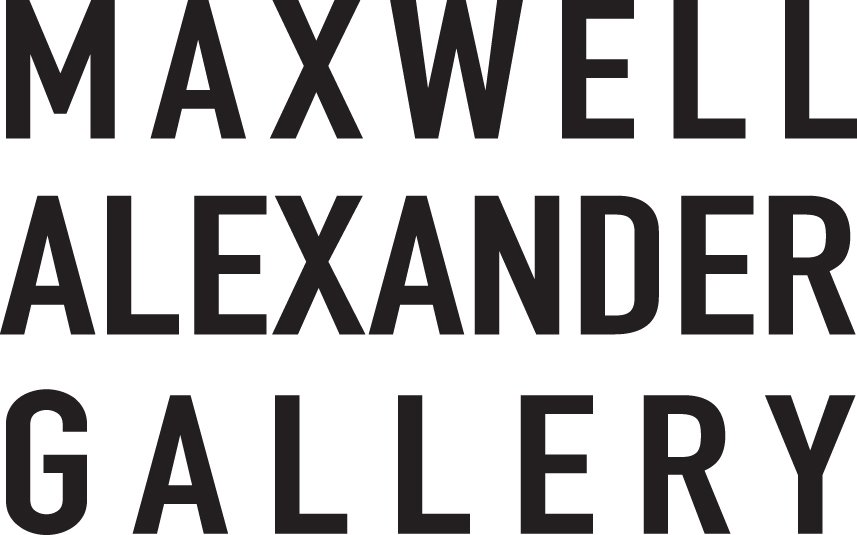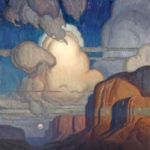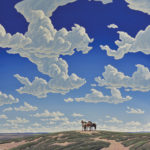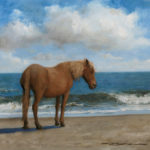Maxwell Alexander Gallery is located in the South Park district of downtown Los Angeles, just a couple streets over from the Convention Center and Staples Center. In recent years, downtown LA has become one of the most sought after locations in Los Angeles. Maxwell Alexander Gallery is continuing its service to out-of-state clientele but has also gained a group of new collectors this past year who are new residents of downtown LA. As a result, sales have doubled in 2018 and the gallery looks forward to continue the trend in 2019. Keeping things interesting with multiple exhibitions running each month in its front and south galleries, the gallery’s primary focus is on high-quality art. “I can say with confidence, no other gallery in the Southwestern market has a roster as strong as ours. We are developing new artists’ careers, but we are lucky to have the biggest names all under on roof,” says Beau Alexander, president. In March, Maxwell Alexander Gallery is hosting a three-person exhibition featuring legendary painters Howard Post, Gary Ernest-Smith and Bryan Haynes. In April, an exhibition will be held for Grant Redden, his Los Angeles debut. In May the gallery hosts the thirst consecutive solo exhibition for Eric Bowman.
Western Art Collector Previews Eric Bowman Exhibition
Eric Bowman endeavors to capture a sense of romance in his Western artwork. It’s not about historical accuracy or highly detailed portrayals of cowboys performing realistic duties; rather, it’s about depicting that heroic, iconic view of the cowboy that has grown in popular culture over the years-the John Wayne and Clint Eastwood figures. Bowman’s upcoming show at Maxwell Alexander Gallery, titled Storybook Cowboy, will be on display from Jun 2 to 30 and includes Western landscape paintings of “the adventurer cowboy-the ones little boys look up to,” says Bowman.
The primarily self-taught artist is dedicated to developing his individual style, explaining that the new Western art market has evolved into something that looks more closely at the telling of a story instead of a strict historical representation of a certain time period.” Even though my work is clearly representational art, I’m saying more with color, line drawing, brush-style artwork that with [specific details],” Bowman says. In more recent years, the conversation around the Western art market has taken on a broader acceptance of a more contemporary approach, he explains.
Echo Canyon, oil has probably the most heroic pose of those pieces. The horse and rider, cast in partial shadow from the canyon behind them, are set in the foreground, putting them at the center of the viewer’s attention. In Green Mountain, that storybook feeling comes from the grand, epic mountain behind him, Bowman says, while Night Watch features a rising moon in dramatic light.
“The cowboy I grew up watching on TV or in the movies….there was always that dichotomy of good and evil, and the cowboy was always the good guy. As a kid, it was something I always looked up to,” Bowman says.
Having begun painting Western scenes in the past three or four years, Bowman says he hopes viewers can see a maturity in his work and subject matter. The California painters are a major source of inspiration, but that he aims to take that influence and blend it with his own voice and style. “There are different ways to say essentially the same things over and over and over,” Bowman adds. “In the end, it’s about expression without hindrance, allowing the character of the subject to “impact” the viewer in a positive and intriguing way.”
For more work by Bowman, click here.
Southwest Art Magazine Previews Eric Bowman
A lone cowboy sits atop a hill overlooking the desert below. As he sits on his horse with his hat pulled down low, he watches the sun fall into the horizon and thinks about his day. There are no houses or cities in the distance. He has no companions with him. Man and horse sit alone in contemplation of the adventures ahead. Eric Bowman’s new body of work drops viewers into these quiet moments in the lives of American cowboys. “This is what I like best about the western genre,” Bowman says. “Hollywood has romanticized that vision of the cowboy, and I’ve always loved it.”
The artist presents 12 of his newest works in a solo show this month, titled Storybook Cowboy, at Maxwell Alexander Gallery. The show opens on Saturday, June 2, with an artist’s reception that evening. The early illustrators of the 1900s, who depicted the American West that soon grew into the expansive western genre of entertainment, influence Bowman’s style and subject matter. The artist is simultaneously paying homage to those artists while putting his own contemporary spin on the subject. To create his new pieces, Bowman worked with models and took photos of modern cowboys and ranch hands for reference. But he changes their clothing for a more historic feel in each piece. “It’s this fusion of contemporary working cowboys and the iconic images we associate with western heroes,” Bowman says. “Nothing would give you a sense of them being contemporary, but they’re still generic enough to belong to any era.”
Gallery director Beau Alexander says the work fits with the gallery’s overall aesthetic that combines old and new. “We respond to that contemporary edge, but Eric still has that masterful technique of someone who has been painting for a long time,” he says. “This show is an exclamation point in his career that will make people take notice of his skill. He won’t be flying under the radar much longer.”
While the artist recently began expanding his figurative oeuvre, his background in landscapes remains strong. “I still want the bulk of the scene to be comprised of the landscape, but these works meld the two genres together to make up that one romanticized, storybook scene,” he says. Nearly all of the pieces feature a solitary cowboy in the wilderness. There are no man-made structures to speak of in the hills around him. Bowman says the loneliness of that lifestyle is a key theme throughout the show. “It’s about the overall feeling you get when you see this cowboy alone, and what he might be feeling from his perspective,” Bowman says.
With most of the pieces set during sunrise or sunset, the artist plays with a unique juxtaposition between subject matter and lighting. “You can make this subject gritty and rough and hard, but with these colors, the cowboy becomes more restful and contemplative,” Bowman says. “With the time of day, the work signifies the end of an era when these men were revered and needed. But if a kid sees them, I want him to think of them as heroes, too.” —Mackenzie McCreary
For more work by Eric Bowman, click here.
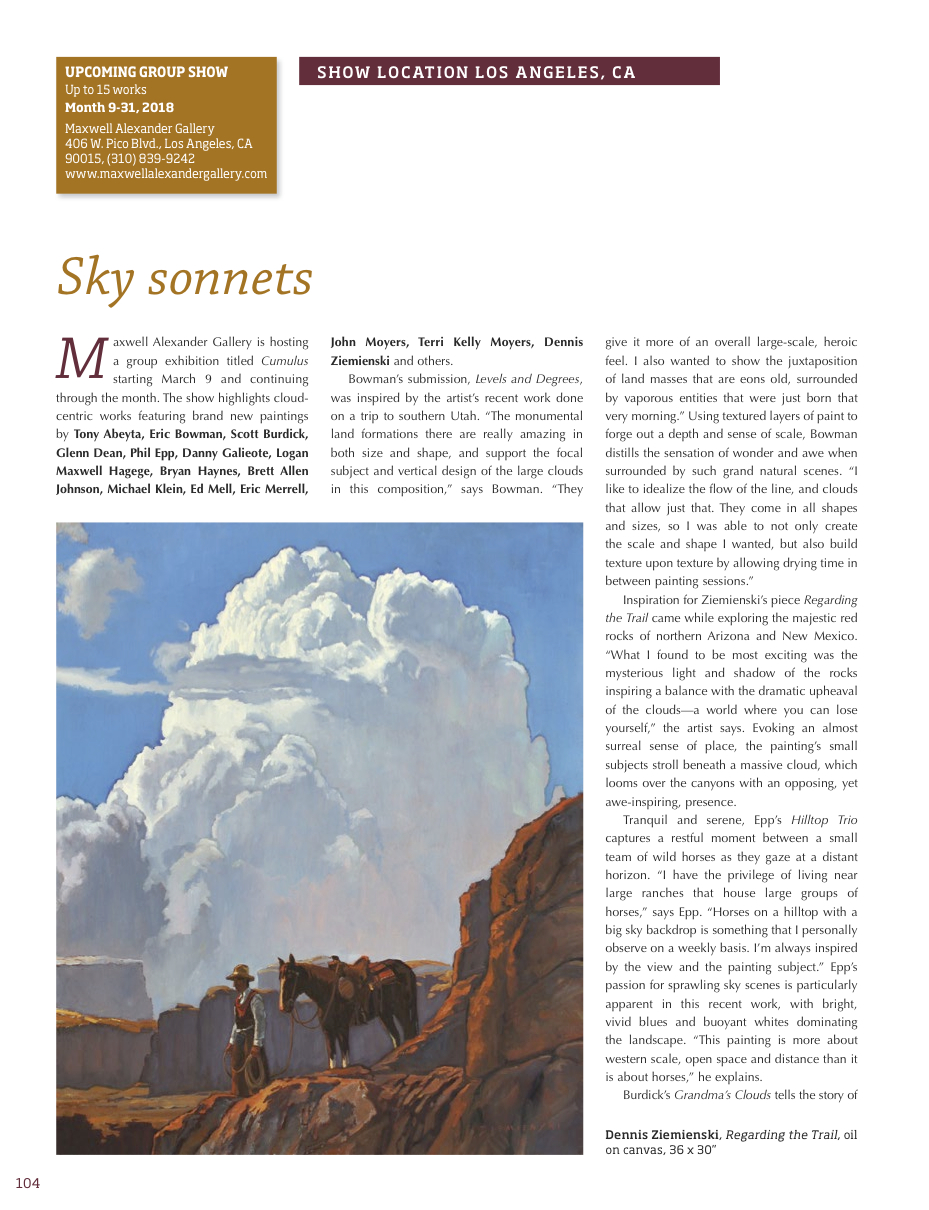
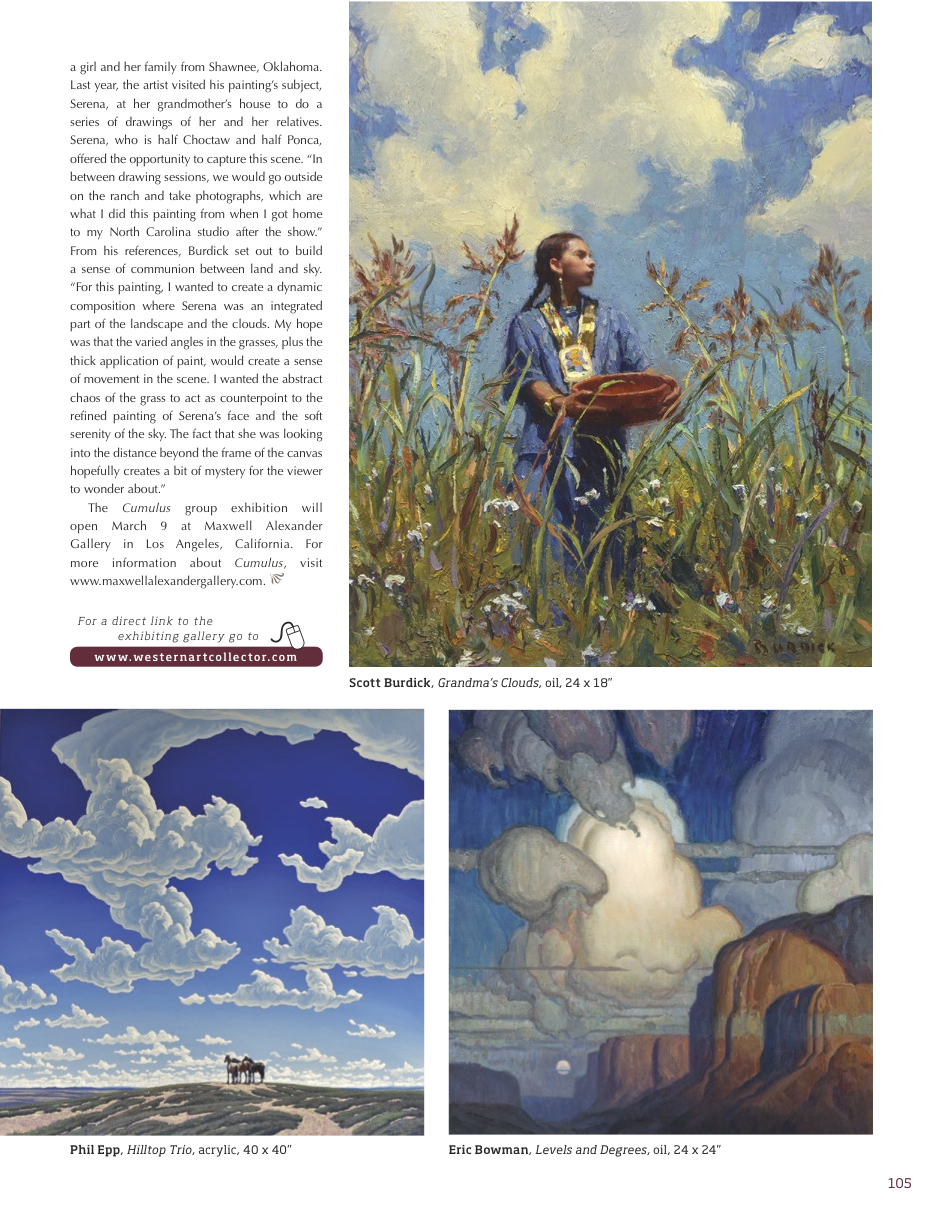
Western Art Collector Previews Cumulus Show
Sky Sonnets
Maxwell Alexander Gallery is hosting a group exhibition titled Cumulus starting March 9 and continuing through the month. The show highlights cloud- centric works featuring brand new paintings by Tony Abeyta, Eric Bowman, Scott Burdick, Glenn Dean, Phil Epp, Danny Galieote, Logan Maxwell Hagege, Bryan Haynes, Brett Allen Johnson, Michael Klein, Ed Mell, Eric Merrell, John Moyers, Terri Kelly Moyers, Dennis Ziemienski and others.
Bowman’s submission, Levels and Degrees, was inspired by the artist’s recent work done on a trip to southern Utah. “The monumental land formations there are really amazing in both size and shape, and support the focal subject and vertical design of the large clouds in this composition,” says Bowman. “They give it more of an overall large-scale, heroic feel. I also wanted to show the juxtaposition of land masses that are eons old, surrounded by vaporous entities that were just born that very morning.” Using textured layers of paint to forge out a depth and sense of scale, Bowman distills the sensation of wonder and awe when surrounded by such grand natural scenes. “I like to idealize the flow of the line, and clouds that allow just that. They come in all shapes and sizes, so I was able to not only create the scale and shape I wanted, but also build texture upon texture by allowing drying time in between painting sessions.”
Inspiration for Ziemienski’s piece Regarding the Trail came while exploring the majestic red rocks of northern Arizona and New Mexico. “What I found to be most exciting was the mysterious light and shadow of the rocks inspiring a balance with the dramatic upheaval of the clouds—a world where you can lose yourself,” the artist says. Evoking an almost surreal sense of place, the painting’s small subjects stroll beneath a massive cloud, which looms over the canyons with an opposing, yet awe-inspiring, presence
Tranquil and serene, Epp’s Hilltop Trio captures a restful moment between a small team of wild horses as they gaze at a distant horizon. “I have the privilege of living near large ranches that house large groups of horses,” says Epp. “Horses on a hilltop with a big sky backdrop is something that I personally observe on a weekly basis. I’m always inspired by the view and the painting subject.” Epp’s passion for sprawling sky scenes is particularly apparent in this recent work, with bright, vivid blues and buoyant whites dominating the landscape. “This painting is more about western scale, open space and distance than it is about horses,” he explains.
Burdick’s Grandma’s Clouds tells the story of a girl and her family from Shawnee, Oklahoma. Last year, the artist visited his painting’s subject, Serena, at her grandmother’s house to do a series of drawings of her and her relatives. Serena, who is half Choctaw and half Ponca, offered the opportunity to capture this scene. “In between drawing sessions, we would go outside on the ranch and take photographs, which are what I did this painting from when I got home to my North Carolina studio after the show.” From his references, Burdick set out to build a sense of communion between land and sky. “For this painting, I wanted to create a dynamic composition where Serena was an integrated part of the landscape and the clouds. My hope was that the varied angles in the grasses, plus the thick application of paint, would create a sense of movement in the scene. I wanted the abstract chaos of the grass to act as counterpoint to the refined painting of Serena’s face and the soft serenity of the sky. The fact that she was looking into the distance beyond the frame of the canvas hopefully creates a bit of mystery for the viewer to wonder about.”
The Cumulus group exhibition will open March 9 at Maxwell Alexander Gallery in Los Angeles, California.
For more work from Cumulus, click here.
Southwest Art Previews Cumulus Show
Los Angeles, CA
Maxwell Alexander Gallery, March 10-31
Dennis Ziemienski, Summer Thunderhead, Monument Valley, oil, 20 x 30.
We probably take them for granted more often than we should. This month, however, clouds receive a well-deserved tribute at Maxwell Alexander Gallery, where 12 leading western artists portray these billowing beauties of the sky in more than a dozen new paintings of the American West. Fittingly titled Cumulus, the exhibition opens on Saturday, March 10.
Devotees of historic western art might presume the show is a commemorative nod to early western landscape painters like Maynard Dixon (1875-1946), who frequently depicted massive, showstopping cloudscapes over low-lying horizons. But gallery owner Beau Alexander is quick to note that, while this group of contemporary painters may be influenced by such artists, it’s not the focus of the exhibition. “We’re really trying to look forward,” he says. “These artists are cutting their own path and doing something a little different.”
Among those portraying clouds in a new light are Eric Bowman, Scott Burdick, Phil Epp, Danny Galieote, and Michael Klein. The artists were invited to interpret the theme in any way—and any size—they saw fit, notes Alexander. The result is a diverse collection of cloud-infused scenes that range in tenor from whimsical to contemplative.
Bowman, a western native, has given the theme plenty of thought himself. “Clouds are such enigmatic elements in our landscape’s skies, constantly moving and shape-shifting, especially here in the West where they’ve helped define wide-open spaces like Montana’s Big Sky Country,” he says.
Clouds typically play a “backup role” in his landscape paintings, says the Oregon artist, but in his major work for the show, titled "Levels and Degrees" they take center stage. “I wanted to create some cloud iconography using various levels of depth, large-mass shapes, and temperature shifts to convey a larger-than-life impact,” he explains. Bowman strategically set his cloudscape over southern Utah’s ancient bluffs and canyons, both to support the composition’s vertical design and to create a “large-scale, heroic feel,” he says. “As a design feature, clouds can theoretically be shaped into any configuration imaginable, and in this case, hopefully they inspire our imagination about how large and legendary the West really is.”
Landscape artist Phil Epp has been painting clouds for years, and like Bowman, he thrills in their potentially endless configurations. In his cloud-dominant painting "Hilltop Trio", Epp portrays a triad of horses in the Kansas hills near his home. They are dwarfed, however, by a cobalt-blue sky with plump, unfurling clouds that fill nearly 80 percent of the picture plane. “In my imagery, it’s basically earth and sky, and clouds become the characters of the scene,” says Epp. “I don’t intend for them to be realistic. I make an effort to show vastness, space, and emptiness. Out West, you’ve got the ground ahead of you and the sky above you, and that’s about as basic and primal as it gets.”
If anyone can inspire us to glance skyward with a deeper appreciation for clouds, surely this group of artists can. “We all know what clouds look like,” notes Alexander, “but it’s not until master artists share their vision that our own vision opens up.” —Kim Agricola
To view the Cumulus exhibition, click here.
